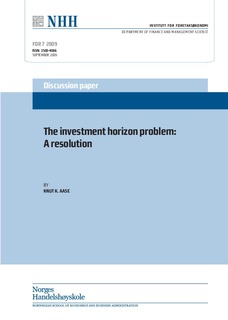| dc.contributor.author | Aase, Knut K. | |
| dc.date.accessioned | 2009-10-19T11:31:13Z | |
| dc.date.available | 2009-10-19T11:31:13Z | |
| dc.date.issued | 2009-09 | |
| dc.identifier.issn | 1500-4066 | |
| dc.identifier.uri | http://hdl.handle.net/11250/163979 | |
| dc.description.abstract | In the canonical model of investments, the optimal fractions in
the risky assets do not depend on the time horizon. This is against
empirical evidence, and against the typical recommendations of portfolio
managers. We demonstrate that if the intertemporal coefficient
of relative risk aversion is allowed to depend on time, or the age of
the investor, the investment horizon problem can be resolved. Accordingly,
the only standard assumption in applied economics/finance
that we relax in order to obtain our conclusion, is the state and time
separability of the intertemporal felicity index in the investor’s utility
function. We include life and pension insurance, and we also demonstrate
that preferences aggregate. | en |
| dc.language.iso | eng | en |
| dc.publisher | Norwegian School of Economics and Business Administration. Department of Finance and Management Science | en |
| dc.relation.ispartofseries | Discussion paper | en |
| dc.relation.ispartofseries | 2009:7 | en |
| dc.subject | the investment horizon problem | en |
| dc.subject | complete markets | en |
| dc.subject | life and pension insurance | en |
| dc.subject | dynamic programming | en |
| dc.subject | Kuhn-Tucker | en |
| dc.subject | directional derivatives | en |
| dc.subject | time consistency | en |
| dc.subject | aggregation | en |
| dc.title | The investment horizon problem : a resolution | en |
| dc.type | Working paper | en |
| dc.subject.nsi | VDP::Samfunnsvitenskap: 200::Økonomi: 210::Bedriftsøkonomi: 213 | en |
